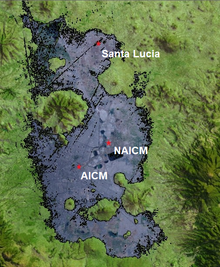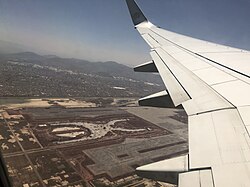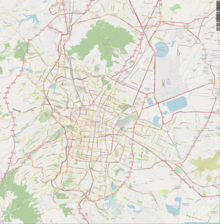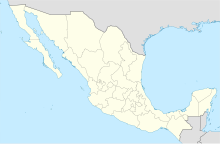
Mexico City Texcoco Airport Aeropuerto de Texcoco, formerly Nuevo Aeropuerto Internacional de México (NAIM) | |||||||||||||||||||||||||||||||
|---|---|---|---|---|---|---|---|---|---|---|---|---|---|---|---|---|---|---|---|---|---|---|---|---|---|---|---|---|---|---|---|
 Aerial view of the proposed airport location, June 2018 | |||||||||||||||||||||||||||||||
| Summary | |||||||||||||||||||||||||||||||
| Serves | Mexico City | ||||||||||||||||||||||||||||||
| Location | Zona Federal del Lago de Texcoco, municipalities of Ecatepec, Atenco and Texcoco, State of Mexico, Greater Mexico City | ||||||||||||||||||||||||||||||
| Coordinates | 19°30′00″N 98°59′51″W / 19.5°N 98.9975°W | ||||||||||||||||||||||||||||||
| Map | |||||||||||||||||||||||||||||||
| Runways | |||||||||||||||||||||||||||||||
| |||||||||||||||||||||||||||||||
Mexico City Texcoco Airport was a planned airport in Mexico City that was meant to become Mexico's New International Airport (Spanish: Nuevo Aeropuerto Internacional de México—NAICM or NAIM). The project was announced in September 2014 but was canceled in late 2018 after a referendum was held stating that the new airport should be built at a different location due to how close it was to close housing, rising cost and a geographical issue with the site. Felipe Ángeles International Airport opened in March 2022.
Texcoco Airport was first announced by President Enrique Peña Nieto in his State of the Union Address on September 2, 2014. It was billed as Mexico's largest public infrastructure work in a century, and was set to replace Mexico City's current Benito Juárez International Airport. [1]
In October 2018, after construction had already begun, a non-binding referendum was organized by then President-elect Andrés Manuel López Obrador, in which almost 70 percent of the 1.067 million voters rejected the planned airport, choosing instead to build a new airport on the grounds of Santa Lucía Air Force Base. [2] [3]
Construction continued for several weeks, but was suspended on December 27, 2018 after López Obrador took office. [4] [5] In 2020, the government of Mexico announced that they would convert the 12,000-hectare (46 sq mi) space where the airport was being built into the Lake Texcoco Ecological Park, which will be a public space and an area of ecological restoration.
Location
Texcoco Airport was to be constructed on a 44-square-kilometre (17 sq mi) site in the Zona Federal del Lago de Texcoco, in part of the dry bed of Lake Texcoco. [6] The site was only 5 kilometres (3 mi) away from the existing Benito Juárez Airport, making the simultaneous operation of the airports impossible. It was therefore planned that all operations and traffic from Benito Juárez would be transferred to NAIM upon the airport reaching operational status.
Costs and financing
The total cost for construction and initial operation of NAIM was estimated at up to US$13.3 billion, of which approximately 60% was to be contributed by the Mexican government through public funds, and approximately 40% was expected to be funded through a combination of bank loans and the offering of debt securities. [7]
The Grupo Aeroportuario de la Ciudad de México (GACM), which is fully owned by the Mexican Secretariat of Communications and Transportation (SCT), was to build and operate the new airport. The GACM created a special purpose trust, the Mexico City Airport Trust, in order to execute the airport's private financing. The trust structured the private contributions as securities drawing from passenger charges at the existing AICM and the future passenger charges of the new airport, without recourse to the Mexican government or the airport sponsors. This collateral structure was designed to ensure that even if the project were to be canceled, the issued bonds would still be honored. [7] [8]
In September 2017, the Mexico City Airport Trust successfully placed US$4 billion in private debt securities for the financing of NAIM. $2 billion were issued in long-term green bonds. This green bond issuance became the largest in Latin America at the time and the first green bond from an emerging market to receive a Green Bond Assessment grade from Moody's Investors Service. [9] [8]
Facilities
The facilities at NAIM were planned to be completed in several stages. By October 20, 2020, the airport was expected to have one main terminal of 8,000,000 square feet (743,000 m2) and three independent runways, which would yield a capacity for 68 million passengers annually. By 2065, the airport was expected to host six runways, an additional main terminal, and two satellite terminals, giving it a capacity for 125 million passengers. This would have made NAIM the second largest airport in the world. [6]
The construction plan for the airport was developed by the global engineering and consultancy company Arup Group Limited. [10] [11] The architectural project was to be designed in collaboration by Norman Foster, who worked on Beijing Capital International Airport and Hong Kong International Airport, and Mexican architect Fernando Romero, who worked on the Soumaya Museum.
Terminal design

The main terminal was to be constructed in an X shape, which is considered an efficient way to extend the number of gates, and is used in many other airports. The X shape is also thought to be symbolic of the country's name, "México". [12]
According to the architects, the terminal was to be built in the style of Mexican architecture and was to be much larger than typical terminals, with a maximum internal span in excess of 170 metres (560 ft). The roof was to be made of a lightweight membrane-like material. The whole terminal was to be constructed using pre-fabricated segments. [13] [14]
| Mexican architect | Foreign architect | Airport technology consultant | Structural engineer |
|---|---|---|---|
| Fernando Romero | Foster and Partners | Netherlands Airport Consultants | Arup |
| Bernardo Gómez Pimienta | Gensler | TransSolutions | Walter P. Moore and Aguilar Ingenieros Consultores |
| Teodoro González de León and Alberto Kalach | Fentress Architects | Landrum & Brown | DITEC/URS |
| Ricardo Legorreta Vilchis | Rogers Stirk Harbour + Partners | Stantec | Stantec |
| Francisco López-Guerra Almada | Helmut Jahn | WSP Group | Werner Sobek Stuttgart and Postensa |
| Enrique Norten | Skidmore, Owings and Merrill | Leo A. Daly | CTC Ingenieros Civiles |
| Serrano Arquitectos y Asociados | Zaha Hadid Architects | Ricondo and Associates | Izquierdo Ingenieros y Asociados, García Hermanos y Asociados, Javier Alonso and WSP |
| Sordo Madaleno Arquitectos | Pascall+Watson | Logplan | Grupo Riobóo |
Sustainability
The project claimed it was "designed to be the world’s most sustainable airport", and was aiming for a LEED Platinum certification. [15] [14]
Antecedents and protests
In 2002, President Vicente Fox announced the construction of a new, larger airport on 5,000 ha (12,000 acres) of land in the municipalities of Texcoco and San Salvador Atenco in the same area as the new airport is planned today. When protests held by the Community Front in Defense of Land - an organization of locals who were to be displaced - were violently repressed, [16] the new airport was cancelled. [17]
Prior to the 2014 announcement of the construction of the new airport, the government had purchased ejido land (agricultural land held in common by local communities), in order to make space for the new airport. Some local groups in Atenco and nearby communities claimed that the federal government had acquired the land through deception and strong-arming, and small-scale protests took place after the announcement. [18] [19] The airport plan drew negative reactions across social media with the new movement, #YoPriefieroElLago, [20] in which the distribution of infographics and "fast facts" spread across various platforms. The movement culminated in the creation of a mini-documentary [21] of the same name documenting the airport plan, the land and space it would require, interviews with Atenco community members, and the proliferation of the social media movement. [22]
Post-closure
According to the SCT, cancellation of the project left a debt of US$6 billion in bonds and $30 billion in securities, which will be paid off through the landing fees at Benito Juárez International Airport over a period of 19 years. This debt is in addition to the $56.8 billion paid to the GACM as compensation for the cessation agreement of the fees. None of the money raised through the landing fees at Benito Juárez can be allocated for the construction of the new Mexico City Santa Lucía Airport or for maintenance of the current airport. [23]
In early 2021, the Superior Auditor of the Federation estimated that cancelling the airport would cost 113 billion pesos. [24]
Alleged fraud
On July 10, 2020, it was alleged that Grupo Gilbert had fraudulently won possession of 49,000 tons of steel that had originally been designated for the NAIM. [25]


On August 12, 2020, Hugo Bello, leader of the Confederacón Libertad de Trabajadores de México (Freedom Confederation of Mexican Workers), was arrested for kidnapping and for suspected involvement in embezzlement of money destined for construction of the now-defunct airport. [26]
Ecological Park project
The Lake Texcoco Ecological Park, officially called Parque Ecológico Lago de Texcoco (PELT), [27] is a project of the government of Mexico which consists of an urban park in the State of Mexico. It is part of the larger metropolitan area in the Valley of Mexico, around Mexico City. [28]
The planned area for the park is 14,000 ha (35,000 acres), [29] of which 4,800 ha (12,000 acres) will be public spaces. [28] The government has announced that the park will open of 30 April 2024. [29] [30] The park was designated after the cancelling of an airport in the same location.
The park has been internationally praised as both a major ecological restoration project, and having great potential for climate adaptation for Mexico City. [31] [32]References
- ^ "Estadísticas del AICM (in Spanish)". Aeropuerto Internacional de la Ciudad de México.
- ^ Redacción (2018-10-29). "Mayoría de votantes en consulta sobre nuevo aeropuerto en México rechaza su construcción" (in Spanish). BBC News Mundo. Retrieved February 14, 2020.
- ^ "Foster's $13 billion Mexico City airport nixed after public vote". Dezeen. October 30, 2018.
- ^ "Obra del NAIM sigue mientras gobierno negocia con acreedores". Animal Político. December 3, 2018.
- ^ Alberto Morales (January 3, 2019). "Construcción de nuevo aeropuerto en Texcoco está oficialmente suspendida: Jiménez Espriú". El Universal (in Spanish).
- ^ a b "Programa Estrategico / Institucional" (PDF). Grupo Aeroportuario de la Ciudad de Mexico (GACM).
- ^ a b Mexico City Airport Trust. "Bond Offering Memorandum" (PDF). GACM.
- ^ a b "Mexico Sells $2 Billion in Green Bonds to Help Finance Airport". The Wall Street Journal. Retrieved September 24, 2016.
- ^ "Bono verde aportará 4 mil millones de dólares para el Nuevo Aeropuerto Internacional". www.elfinanciero.com.mx. Retrieved October 2, 2017.
- ^ "Plans for a new Mexico City Airport being reviewed - Airport World Magazine". Airport-world.com. June 25, 2014. Retrieved November 12, 2015.
- ^ Alper, Alexandra (June 19, 2014). "New airport plan for Mexico City eyes six runways: sources". Reuters. Retrieved November 12, 2015.
- ^ "9 puntos clave sobre el nuevo aeropuerto de la Ciudad de México - Exportaciones - Nacional - CNNMexico.com". Mexico.cnn.com. Archived from the original on 2015-11-09. Retrieved 2015-11-12.
- ^ "Norman Foster, Romero to build Mexico airport". Reading Eagle. September 3, 2014. Archived from the original on March 3, 2016. Retrieved November 12, 2015.
- ^ a b "F+P & FR-EE Fernando Romero to collaborate". Fosterandpartners.com. Archived from the original on November 15, 2015. Retrieved November 12, 2015.
- ^ "Mexico City's New Mega-Airport Will Collect Its Own Energy and Water". Gizmodo.com. Retrieved 2015-11-12.
- ^ Berehulak, Daniel (21 September 2016). "The Women of Atenco". The New York Times. Retrieved 2022-03-24.
- ^ Thompson, Ginger (August 3, 2002). "Mexico Drops Planned Airport After Protests From Peasants". The New York Times. Retrieved November 12, 2015.
- ^ "Con "toma" de maquinaria, Atenco inicia protestas contra aeropuerto — La Jornada" (in Spanish). Jornada.unam.mx. Archived from the original on March 4, 2016. Retrieved November 12, 2015.
- ^ "DF - Reactivan lucha en Atenco contra aeropuerto". El Universal. Retrieved November 12, 2015.
- ^ RamÍrez, Salvador Ferrer (October 7, 2018). "La campaña #yo prefiero el lago". El Universal. Retrieved April 11, 2023.
- ^ mini-documentary
- ^ "Yo Prefiero el Lago - México". Bombozila (in European Spanish). 2019-10-19. Retrieved 2022-11-16.
- ^ "A canceled airport will become a financial burden for passengers". El Universal (in Spanish). 24 June 2019. Retrieved August 13, 2020.
- ^ "Cancelar el aeropuerto de la CDMX costó 113 millones de pesos". Diario de Yucatán (in Spanish). May 9, 2021.
- ^ "Denuncian corrupción en licitación por venta de acero del NAIM". www.msn.com. Retrieved July 10, 2020.
- ^ "Hugo Bello, detenido ayer, es investigado por desvío millonario en NAIM". El Universal (in Spanish). August 13, 2020. Retrieved August 13, 2020.
- ^ SEMARNART. "Proyecto ecológico Lago de Texoco" (PDF). Retrieved 26 June 2021.
- ^ a b "Gobierno de AMLO presenta proyecto de Parque Ecológico para rescatar Lago de Texcoco". Forbes. Retrieved 25 June 2021.
- ^ a b "Así será el Parque Ecológico del Lago de Texcoco". Retrieved 15 June 2022.
- ^ https://diarioportal.com/2024/01/17/con-81-de-avance-conagua-estima-apertura-del-parque-ecologico-lago-de-texcoco-en-abril-2/
- ^ "Mexico City is proposing to build one of the world's largest urban parks. Will it serve as a climate adaptation example for other cities?". Ensia. Retrieved 2021-10-03.
- ^ "Will Mexico City's massive new park be a climate adaptation paragon for other cities? | Greenbiz". www.greenbiz.com. Retrieved 2021-10-03.
External links
- "NAICM official website" (in Spanish). Archived from the original on 2017-11-19. Retrieved 2017-09-29.
- FR-EE's presentation
- Video at Foster + Partners website
- Airport site map on "Aeropuerto de la ciudad de México: aterriza proyecto" [Mexico City airport: project lands]. El Economista (in Spanish). 2014-09-02.
- Referendum threatening the building of the airport
- 2020 in Mexico
- 2020 in transport
- Mexico City International Airport
- National symbols of Mexico
- Foster and Partners buildings
- Proposed airports
- Transportation in Mexico City
- Proposed transportation infrastructure in Mexico
- Airports in the State of Mexico
- 2020s in Mexico City
- Texcoco, State of Mexico
- Cancelled airports


